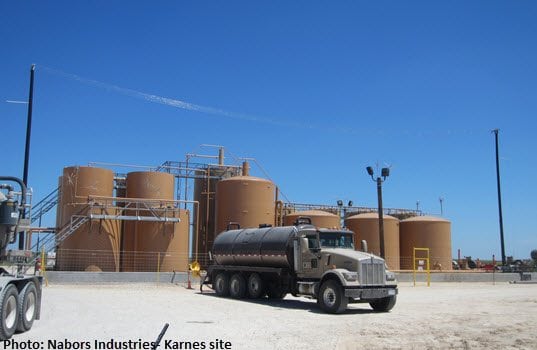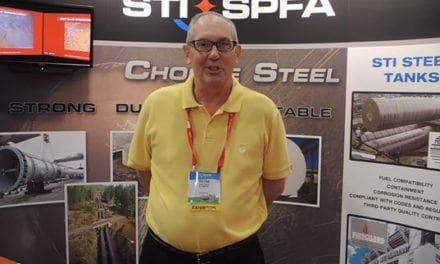Introduction by JoOnna Silberman, marketing coordinator, Lightning Eliminators & Consultants
Last summer quickly became the “Season of Exploding Tanks” as we saw a seemingly upward trend in lightning events across the United States. States that don’t usually experience a high volume of lightning events as a rule had an increase. In states where lightning is common, we saw Mother Nature at her most volatile; bigger, badder storms reaping destruction starting earlier and continuing longer. It appeared as though a week didn’t go by where we didn’t read of a storage tank facility experiencing some sort of incident. But not every event was due to a direct lightning strike—in fact most of the accidents were not the result of a direct hit at all. If not a direct hit than what else could account for this phenomenon? As we prepare for the 2014 season of electrical Russian roulette globally we need to explore the causes and take precautions to protect our tanks from the potential of arc, spark and boom!
Sparking inside and outside of tanks is one of the most prevalent instigators of storage tank disasters across the world. Studies done in recent found that most Storage Tank explosions are caused by lightning, but what is not realized is that the secondary effects of lightning are statistically much more damaging. Whether upstream or downstream, oil and gas, chemicals and/or byproduct from exploration combustible liquids have to be protected. Grounding engineering for tanks needs to be considered for all flammable stored liquids. If you are a tank terminal, tank battery or even have just one storage tank that contains an incendiary substance, not only should you be implementing a lightning protection solution, but you should be incorporating grounding engineering and taking proactive measures against arc discharge events by providing solutions for both inside and outside the tank.
While there have been solutions in place for metal storage tanks and Arc Discharge events through products such as the Retractable Grounding Assembly (RGA) for years, a relatively new problem has taken center stage with the increased usage of non-metal and lined tanks which is outlined more succinctly in a technical note by my colleagues Dr. Al Gasiewski and Lee Howard of which I have chosen excerpts for the purpose of this article. The entire “Technical Note” of the same title can be found on the Fuel Marketer News Market Place website: Chemical Storage Tank Arc Discharge Mitigation. Excerpts from the technical note:
Chemical Storage Tank Arc Discharge Mitigation
Excerpts from a technical note
By: Albin J. Gasiewski Ph.D., CTO, Enventa, LLC & Lee B. Howard, Electrical Engineering Manager, Lightning Eliminators & Consultants, Inc.
Background: The problem of electrical discharge and subsequent explosive detonation of the ullage inside chemical storage tanks containing methane-infused fluids is becoming more widespread as the use of new non-metallic storage tanks proliferates. The gas inside the tank above the fluid level (the tank’s ullage) can contain a stoichiometrically explosive mixture of oxygen and methane or other similarly volatile hydrocarbon gas. Such a mixture is amenable to explosive detonation upon either arc or strong corona discharge within the tank.
The use of non-metallic tank walls permits electric fields to approach breakdown strength in response to a nearby lightning discharge. Furthermore, enhanced local electric fields that exceed breakdown strength can occur near either small metallic objects or even dielectric objects within the ullage region of the tank.
Origin of Tank Explosions: It is hypothesized that the cause of recent explosions of ullage in fracture fluid storage tanks is the result of the above field amplification near sharp ungrounded metallic objects or sharp dielectric protrusions. Rapid increases in the external field of order 2MV/m per millisecond will cause field amplification on many small dielectric and conducting objects within a non-metallic tank. The rapidity of this field change does not permit time for charge to bleed off through the insulating tank walls, and thus to null out the applied external field from the lightning transient. A rapidly increasing field that exceeds the local dielectric breakdown strength at a location in the vicinity of a lightning strike can readily produce additional localized corona or even arc discharge by exceeding the breakdown strength of the gas mixture
Retrofitting Non-metallic Tanks for Safety: The recommended solution to the above problem is to create a metallic Faraday cage, even if incomplete, around the non-metallic tank and connecting this structure to a low-impedance earth ground at the base of the tank. An incomplete Faraday cage might be formed by, e.g., two looping arches of wire or other conductor over the tank, each offset at 90 degrees to each other.
Additional protection from charges that may be built up on the surfaces of the fluid mass can be obtained by use of a non-corrosive grounding electrode inserted into the fluid and electrically connected to the external Faraday cage conducting members. This electrode provides a means of rapidly discharging the fluid and will also be partially effective as the Faraday cage since it will also serve to null the vertical component of the electric field within the ullage. In fact, since this electrode needs to be grounded, there will always be at least one conductor of the Faraday “birdcage” going to ground outside of the tank. A partial Faraday cage will thus necessarily be built when this conductor is installed. For this purpose, a smooth walled stainless steel pipe serves as an ideal electrode. An example of this is the IPE by Lightning Eliminators.
In general, it is not recommended that any additional sharp metallic objects be placed inside the tank, like a spline brush, and especially within the region of the ullage. Such additional metallic objects – whether if grounded by connection to the electrode conductor or ungrounded – can serve to enhance field strengths and initiate arc discharge within the ullage.
 JoOnna Silberman, marketing coordinator, Lightning Eliminators & Consultants — The LightningDiva@ Large
Film Production Coordinator turned Marketing Professional in the mid 1980’s JoOnna has been a Marketer for over 30 years. After attending, Bard College, The University of Arizona and The New School University she began her career as a production coordinator on feature films, commercials and documentaries. Upon the birth of her daughter 5 years later, she moved back the United States and worked as an independent marketing consultant on projects for The Miami Beach Chamber of Commerce; Hospitality Association of Miami Beach, AMEX Hotel Nice Program, the Louisiana Foreign Relations Associations, and American Models and Designers Awards. Proudly, she was also the catalyst in bringing the late great jazz icon Israel Lopez (Cachao) from Cuba for his first U.S. Concert in South Beach, Florida in 1993. After 15 years and a need for something new, JoOnna to responded to a posting for a position with a company specializing in Lightning Protection, Lightning Eliminators & Consultants where she has been since June 2011 managing all aspects of their marketing to over 8 countries and throughout the United State.
Contact: 303-951-3158 / [email protected]
JoOnna Silberman, marketing coordinator, Lightning Eliminators & Consultants — The LightningDiva@ Large
Film Production Coordinator turned Marketing Professional in the mid 1980’s JoOnna has been a Marketer for over 30 years. After attending, Bard College, The University of Arizona and The New School University she began her career as a production coordinator on feature films, commercials and documentaries. Upon the birth of her daughter 5 years later, she moved back the United States and worked as an independent marketing consultant on projects for The Miami Beach Chamber of Commerce; Hospitality Association of Miami Beach, AMEX Hotel Nice Program, the Louisiana Foreign Relations Associations, and American Models and Designers Awards. Proudly, she was also the catalyst in bringing the late great jazz icon Israel Lopez (Cachao) from Cuba for his first U.S. Concert in South Beach, Florida in 1993. After 15 years and a need for something new, JoOnna to responded to a posting for a position with a company specializing in Lightning Protection, Lightning Eliminators & Consultants where she has been since June 2011 managing all aspects of their marketing to over 8 countries and throughout the United State.
Contact: 303-951-3158 / [email protected]







